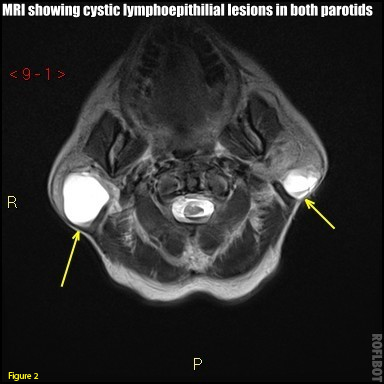Bilateral Parotid Swellings in an HIV-Positive Patient
A large minority of persons with HIV infection have head and neck symptoms; parotid swellings have been noted in approximately 5% to 10% of patients with HIV-1 infection.

A 46-year-old African American woman was brought to the emergency department with altered mental status. The patient had received a diagnosis of HIV infection 3 months earlier. Antiretroviral therapy (ART) had been started at that time, but the patient was consistently noncompliant with the regimen.
In the ED, the patient was afebrile, with a blood pressure of 110/80 mm Hg. Her respiratory rate was 16 beats per minute; pulse, 95 beats per minute. She was oriented to time and person, but not to place. Her CD4 count was 248/μL. The CD4:CD8 ratio was estimated to be 0.14.
Head and neck examination revealed bilateral, non-tender, non-fluctuant parotid swelling. There was no lymphadenopathy or tenderness. Intraoral examination showed dry mucosa. Milking of the parotid gland did not produce any secretion or pain.

The altered mental status/delirium was attributed to dehydration, and patient improved with fluid resuscitation within 48 hours.
CT scan and MRI of the head and neck showed normal midline structures. Multiple masses were seen bilaterally in the parotid glands; the largest mass on the right side measured 3 cm; the largest on the left measured 1.2 cm (Figures 1 and 2).
At the time of discharge, ART was reinstituted and patient was followed up in an HIV clinic. Her parotid swelling resolved completely within 2 months after restarting the ART. The patient had been strongly compliant with the therapy.
Key Points:
About 40% of persons with HIV infection have head and neck symptoms; parotid swellings have been noted in approximately 5% to 10% of patients with HIV-1 infection. These swellings are the result of increased lymphoproliferative activity or lymphoepithelial cyst formation in response to HIV infection.1-4 The parotid manifestations related to HIV infection have a benign course.5
Bilateral parotid swelling may be the first sign or symptom of HIV infection. Patients typically present to the clinician or dentist concerned about the cosmetic appearance of the swelling. For unknown reasons, bilateral involvement is more common than unilateral swelling.2,6
Benign lymphoepithelial lesions are the most commonly reported salivary gland pathology in persons with HIV infection.
Antiretroviral therapy is now the gold standard in the treatment of parotid gland swellings and lymphoepithelial lesions. Many patients report regression of both oral mucocele and parotid swelling following antiretroviral therapy.3,5
References:
1. Owotade FJ, Fatusi OA, Adebiyi KE, et al. Clinical experience with parotid gland enlargement in HIV infection: a report of five cases in Nigeria. J Contemp Dent Pract. 2005;15(6):136-145.
2. Mandel L, Surattanont F. Regression of HIV parotid swellings after antiviral therapy: case reports with computed tomographic scan evidence. Oral Surg Oral Med Oral Pathol Oral Radiol Endod. 2002;94(4):454-459.
3. Syebele K. Regression of both oral mucocele and parotid swellings, following antiretroviral therapy. Int J Pediatr Otorhinolaryngol. 2010;74:89-92.
4. Mandel L, Alfi D. Drug-induced paraparotid fat deposition in patients with HIV: case reports. J Am Dent Assoc. 2008;139:152-157.
5. Mandel L, Hong J. J Am Dent Assoc. 1999;130(4):528-532.
6. Mandel L, Vakkas J. Parotid enlargement in patient with HIV. N Y State Dent J. 2005;71:44-46.